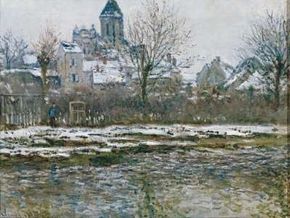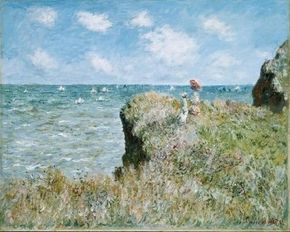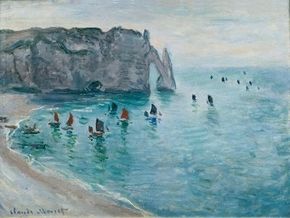Critic Georges Lecomte once described Claude Monet as "the epic poet of nature...full of enthusiasm, indulgence, and serenity, extracting from nature all of its joy." This pursuit to understand nature through art is clearly visible in Monet's works from 1879 to 1886.
During the first stages of his career, Monet concentrated on nature in familiar sites. He returned to his boyhood home in Le Havre and set up his easel where he first painted the sea. But by the 1880s, Monet felt compelled to turn his attention to new sites and new challenges. Over the course of the decade, he traveled to select destinations, traversing regions on foot and immersing himself for months in solitary work.
Advertisement
Monet painted relentlessly, often in brutal weather conditions, to test his physical endurance as well as his powers of observation. From 1882 through 1886 Monet made annual winter journeys to the villages of Etretat, Dieppe, and Pourville along the Channel coast of Normandy. He selected sites along the jagged shoreline and set up his easel looking out over the seas from a high point of view.
In 1883, Monet traveled with friend Pierre Auguste Renoir to the Riviera resort town of Bordighera. Here Monet found an alternative vision to the cold northern light, and an unprecedented challenge: the radiant colors of the southern Mediterranean. For three months, Monet worked from dawn to dusk, painting on four canvases at once, aiming to capture the high color he saw everywhere around him.
In 1886, Monet went to the coast of Brittany, drawn to the rugged terrain and jagged rock formations that jutted up out of the sea. He defined a desire to test himself by using darker tones in contrast to his usual pale palette. To do so, he braved the winds and rains of the harsh sea squalls to capture the deeper tones of the rocks when they were wet.
For all his daring and endurance, Monet won much admiration and also transcended his reputation as an Impressionist.
To learn more about how Monet became the "epic poet of nature," see these Claude Monet paintings from 1879-1886:
- Church at Vétheuil with Snow: Claude Monet's Church at Vétheuil with Snow was painted using a broken brush stroke to suggest the glimmer of low winter light. Learn about Church at Vétheuil with Snow, a painting Monet submitted to the fourth Impressionist exhibition.
- The Break-up of the Ice: Claude Monet's The Break-up of the Ice is a scene of sliding snow from the unusually harsh winter of 1879. Learn about The Break-up of the Ice, which is now housed at The University of Michigan Museum of Art, Ann Arbor.
- The Artist's Garden at Vétheuil: The Artist's Garden at Vétheuil depicts Claude Monet's youngest children in a garden path of giant sunflowers. Learn about The Artist's Garden at Vétheuil, a painting dominated by complementary colors.
- Bouquet of Sunflowers: Claude Monet's Bouquet of Sunflowers evoked surprise and praise from the critics. Learn about Bouquet of Sunflowers, Monet's mastery of a more traditional floral still life.
- Cliff Walk at Pourville: In Cliff Walk at Pourville, Claude Monet depicts Alice Hoschedé and her daughter looking out toward the summer sea. Learn about Cliff Walk at Pourville, which can be seen at The Art Institute in Chicago.
- Low Tide at Pourville near Dieppe: Low Tide at Pourville near Dieppe shows the rising cliffs of a French coastal town where Claude Monet made temporary residence. Learn about Low Tide at Pourville near Dieppe, a painting about the volatile effects of nature.
- Cabin of the Customs Watch: Claude Monet's Cabin of the Customs Watch has a cool tonality with silvery pink flowers and foam-crested waves. Learn about Cabin of the Customs Watch, an icy sea scene of Pourville in late winter.
- The Cliff at Dieppe: In The Cliff at Dieppe, Claude Monet depicts a white chalk cliff crowned by an old stone house. Learn about The Cliff at Dieppe, painted by Monet as he traveled the Normandy coast.
- Coucher de Soleil à Etretat: Coucher de soleil à Etretat shows the rugged Channel Coast cliff that gave Claude Monet new inspiration. Learn about Coucher de soleil à Etretat, a dramatic view of the sea at sunset.
- The Manneporte (Etretat): In The Manneporte (Etretat), Claude Monet uses thick brush strokes to portray the choppy motion of the sea. Learn about The Manneporte (Etretat), a wintry painting housed at The Metropolitan Museum of Art, New York.
- Villas in Bordighera, Italy: Villas in Bordighera, Italy heated up Claude Monet's usually pale palette. Learn about Villas in Bordighera, Italy, nature seen from the view of a popular Mediterranean resort town.
- The Departure of the Boats, Etretat: In The Departure of the Boats, Etretat, Claude Monet depicts rainy weather in a fishing village. Learn about The Departure of the Boats, Etretat, a shoreline painting Monet created from his upper floor hotel room.
- Etretat, Gate of Aval: Fishing Boats Leaving the Harbor: Claude Monet's Etretat, gate of Aval: Fishing boats leaving the harbor is a cliff scene done with softer effect. Learn about Etretat, gate of Aval: Fishing boats leaving the harbor, a painting which features the rock formation Falaise d'Amont.
- Rocks at Belle-Isle, Port-Domois: In Rocks at Belle-Isle, Port-Domois, Claude Monet looks down onto the rocky coast of a restless sea. Learn about Rocks at Belle-Isle, Port-Domois, a painting with deep contrast in both color and stroke.
- Storm, Belle-Isle Coast: For Storm, Belle-Isle coast, Monet modified his usual pale palette to capture a leaden sky. Learn about Storm, Belle-Isle coast, a dramatic example of Monet's willingness to brave the elements of nature for art.
Claude Monet's Impressionist fascination with nature begins with a wintry, snow-clad landscape. Learn about Monet's Church at Vétheuil in the next section.
For more about art, famous artists, and art history, check out:
Advertisement















